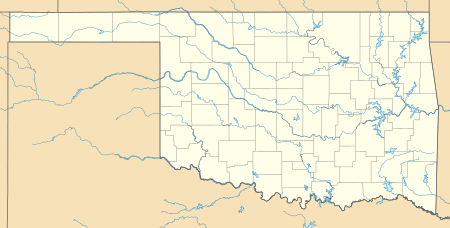Kenwood Historic District (Enid, Oklahoma)
The Kenwood Historic District is located north west of downtown Enid, Oklahoma and is named for Kenwood Boulevard, a diagonal street created in 1894. The neighborhood encompasses 160 acres (0.65 km2) of housing created between 1895 and 1915.[2] Houses in the district were designed by A.A. Crowell and R.W. Shaw, and feature American Foursquare-styled homes.[3]
Kenwood Historic District | |
 | |
| Location | North boundary is Oak, south is Maple, east is Washington, and west is Madison street, Enid, Oklahoma |
|---|---|
| Coordinates | 36°24′3″N 97°53′0″W |
| Architect | R.W. Shaw, A.A. Crowell |
| Architectural style | Prairie School American Foursquares, Bungalow Craftsman, Colonial Revival, Shingle, Neoclassical, Tudor Revival[1] |
| NRHP reference No. | 04001328 |
| Added to NRHP | 2004 |
History
N. E. Sisson and Maurice A. Wogan both laid claim to the land in the Land Run of 1893.[1] Following a period of dispute, Sisson relinquished his claim, and the land became known as the Wogan Block.[1] The land was the first platted area for the city of Enid.[4] In 1895, Wogan sold the land to the Kenwood Land and Development Company, owned by Harrison Lee and his son-in-law Territorial Attorney General W.O. Cromwell.[1] In the early days of Enid, the neighborhood became a home for wealthy businessmen, including Territorial Governor Frank Frantz, and his brothers, Montgomery, William, and Edmund Frantz.[1]
References
- National Register of Historic Places Inventory/Nomination for Kenwood Historic District, #04001328 (PDF), National Park Service, 2004, archived from the original (PDF) on 2010-06-24
- Architectural/Historical Survey of Certain Parts of Enid, Meacham and Associates, 1992, page 10.
- Architectural/Historical Survey of Certain Parts of Enid, Meacham and Associates, 1992, page 35.
- Architectural/Historical Survey of Certain Parts of Enid, Meacham and Associates, 1992, page 24.